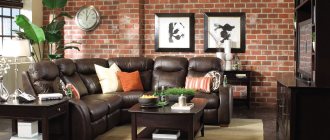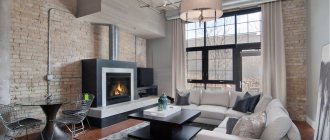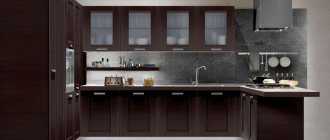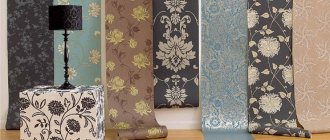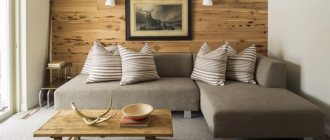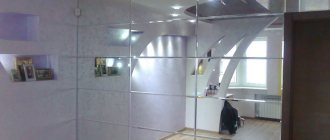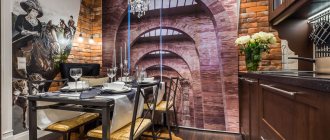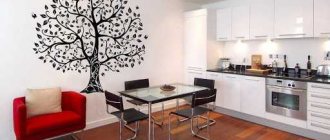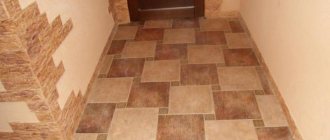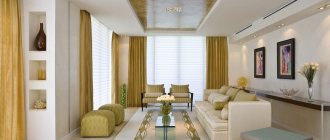Decorating living rooms with natural materials is a good tradition in interior design. The long-loved stone, forged metal, and wood were joined (since the mid-20th century) by brick. Having become a successful mainstream in the living space furnishing segment, this material gives rooms an individual aesthetic. The apparent deliberate roughness of the brickwork in the interior emphasizes the originality of the room, its figurative contrast and immediately attracts attention - the desire to touch it with your hand involuntarily arises.
White brick in the interior gives the room a special aesthetics
A white brick wall favorably sets off the decorative elements of the room: furniture, textiles, decor. Against its background, color accents sound in a new way and texture nuances in the interior of each room are revealed. Moreover, this is not only an affordable way of original finishing, but also the possibility of creative use of various functional designs:
- columns;
- niche;
- protrusions;
- arched recesses.
Decorative elements against a white brick wall will look new
Wall decoration with white brick: pros and cons
White brick is used quite often in the interior. It can be combined with the design of almost any room, and therefore will be an excellent solution for implementing many stylistic ideas. A white brick wall has its pros and cons. They allow you to understand whether it will be possible to implement design ideas using this element.
| Pros of white brick | Cons of white brick |
| 1. White elements in interior design visually increase the space. 2. With the help of white brick in the interior you can revive almost any style. 3. White brick masonry is available in different price categories and from different materials. 4. Suitable for bedroom, kitchen, hallway, living room and many other rooms. 5. Dense masonry provides good sound insulation. 6. Visually smoothes the uneven surface of the wall. | 1. A room with such renovation requires regular cleaning. 2. A panel made of gypsum and similar materials is afraid of moisture. 4. Professional finishing from natural materials will not be cheap. |
White brick in interior styles
White bricks can be combined with various interior styles. The main thing is to know what accents need to be made and where to emphasize the uniqueness of the combination for the sake of the interior design.
Scandinavian style
White decorative brick in a Scandinavian style interior should play one of the leading roles. Nordic design notes love cool and light colors, so it is better not to choose small areas. Large white brickwork will be appropriate on the entire surface of the wall of a living room, bedroom or hallway in a Scandinavian style.
Loft
In the loft style, surfaces finished with red brick or other materials with “natural” shades are more common. But the good thing about this style is that it combines many unusual solutions with an emphasis on brevity and a challenge to glamor. An imitation of natural white brick would be appropriate in a nursery or living room. To enhance the brightness of the style, it is worth choosing contrasting decorative elements, black or brown, made of wood and metal.
Provence
In the Provence style, the material is appropriate only in the interior of the kitchen: a small apron with neat masonry will become a bright accent of the room, which should not be overloaded with an abundance of other decorative elements.
Classic
Classic and white brick go well together. The material or its imitation would be appropriate in the living room. The white masonry above the fireplace will be the highlight of the room.
boho
White brick tiles in a boho interior will reduce the brightness level. It can be used to decorate the wall of a living room, bedroom or kitchen. To emphasize the ethnic boho mood, the masonry is decorated with hanging decor - carpets, jewelry, masks with fringe made from natural fabrics and materials.
High tech
Interior design in high-tech style is rich in dark, cool shades: gray, black, dark brown. The combination with a white brick wall will be advantageous if the masonry imitates natural material. It is better to cover the surface with glossy varnish and not use dense textures.
English style
This direction has absorbed several styles at once. Elements of country, loft, the mood of Provence and classics - all this is the English style, most appropriate for country housing. Here, brick is used in large spaces, more often in the kitchen and living room. Paintings, dark furniture and wood will dilute the light walls.
Modern interior
The apartment in a modern style combines many directions. To prevent the decor from looking pretentious and aggressive, use a plaster background made of white brick. Living room, bedroom - modern style masonry will be appropriate everywhere except the bathroom.
Color spectrum
To create a perfect interior by simulating brickwork, it is important to maintain the color scheme in the interior. How to select wallpaper by tone, taking into account the interior and lighting of the room?
The modern construction market offers a huge number of materials for brick walls:
- matte;
- light;
- rough;
- under red brick;
- dark;
- glossy
Attention! Rough, matte, dark materials hide space and light in the room.
To visually expand the space in the room, light and glossy brick-like materials are suitable. With their help you can give the room the effect of additional lighting.
Original tips and recommendations for the use of such materials in a modern interior are included in the video fragment
The colors of such materials should be as close as possible to natural colors: red, black, brown, gray.
In construction supermarkets there are many tones of wallpaper to match brickwork. You can create bright colors with your own hands, armed with creative imagination, patience, decorative elements, and decorations.
Advice! White wallpaper in a children's room looks unusual if it is diversified with bright decorative elements.
In which rooms is brick suitable?
White brick interior is an ideal solution for almost all rooms. It is less common in the toilet and bathroom, more often in the kitchen, living room and hallway.
What goes with white brick in the interior?
In the interior of an apartment or country house, white brickwork is appropriate almost everywhere. What material goes best with:
- wooden cabinets, furniture, dishes;
- metal tables, racks;
- concrete plates;
- mirrors of standard shapes;
- wallpaper or plain putty;
- home flowers in plain pots and cache-pots.
Simulation options
There are several simple ways to achieve a brick effect in the interior. The simplest option would be to use a natural wall if you are decorating a room in a brick house. In this case, it will be enough to simply treat the walls with protective agents and paint them in the chosen shade. Professionals recommend this design for urbanism, minimalism, and loft.
In many cases, there is no need to correct defects in brick surfaces. The natural design of a brick wall, along with small cracks, irregularities, and roughness, will look stylish and give the brick wall additional charm.
White brick wall in various rooms
A white brick wall adds light and a well-groomed look to the interior. Therefore, it is found in many rooms.
Hallway
White brick in the interior of the hallway is one of the best types of wall decoration. If the space is small, it will visually enlarge it. But then, instead of natural material, it is better to use clinker and wallpaper. In a wide hallway, you can make white masonry from natural brick, diluting it with contrasting furniture or laconic decorative elements - paintings, vases, souvenirs on the shelves.
Living room
White brick in the living room interior should not “argue” with other decorative elements. It is better to put it behind furniture, a TV, large paintings or a fireplace.
Kitchen
When laying brick kitchen backsplashes, you should choose a reliable material: it should be resistant to high temperatures and water, easy to clean and preferably with a glossy varnish coating (makes maintenance easier). Brick-like wallpaper is also appropriate in the kitchen interior: you can dilute the light walls with flat pictures, flowerpots or hanging decor.
Bedroom
There should be little white brick in the bedroom interior. It is enough to decorate the space behind the bed with it so as not to deprive the room of warmth and comfort. Decor made from natural materials is the best solution for contrasting finishing of a brick surface.
Bathroom
A bathroom with white brick is rare. But it is quite appropriate if it is a natural material or clinker. It is better to install the tiles on 1-2 walls, diluting everything with a set of furniture or plumbing fixtures in the same style.
Balcony and loggia
MDF and natural brick for a balcony are not an option. The first one is afraid of cold weather, the second one is too heavy material. But you can use clinker, PVC or cover all the walls with wallpaper.
Textured brick-like materials
Textured materials that imitate natural brick look quite natural on the surface of the walls. Thanks to the relief base, a visual effect arises, and one gets the impression that there is real brickwork on the wall. Modern manufacturers of such trellises offer several options for simulating a textured look: red brick, decorative stone.
Compared to natural brickwork, brick-look wallpaper has quite significant advantages. First, it is necessary to mention their reasonable cost, ease of maintenance, and accuracy in gluing in comparison with brickwork.
Advice! Whether to choose textured materials or try to cover the wall with natural material is, of course, up to the owner of the living space to decide.
Among the most common options for imitation brickwork, we highlight the use of a vinyl base. There are several objective reasons for such a choice. The demand for vinyl materials with a “brick” pattern is explained by the ease of gluing them to the wall, excellent external characteristics, and the ability to repaint decorated walls up to ten times without losing the aesthetics of the surface.
If we analyze the price range for different types of wall finishing materials, then paper trellises are the most inexpensive. But the naturalness and quality of vinyl sheets is much higher, so they have a fairly impressive service life in comparison with their inexpensive paper counterparts.
In modern interior fashion, you can increasingly see brick imitation when decorating walls in bars, cafes, and office spaces. White brick is considered a tribute to fleeting interior fashion.
It attracts attention, makes the atmosphere in the room refined, inimitable, and unique. Due to the effect of visually increasing the space of a room, such brickwork is suitable even for the design of small-sized apartments, which is especially important for the secondary real estate market, numerous Khrushchev-era apartment buildings.
Among the latest fashion trends that designers are focusing on is the introduction of an urban style, which involves finishing the walls with natural brickwork. This allows you to create unique accents in the room, create comfort and a favorable atmosphere for relaxation and relaxation. With the right selection of shades, you can enjoy the amazing interior decoration of your home.
Varieties
Brick walls can be not only natural, but also an imitation of the material. The choice of a specific type depends on the style, size of the room and the characteristics of the tile.
From plaster
It is light in weight and is not afraid of temperature changes. However, it cannot be used in rooms with high humidity.
Made of ceramics
The material is suitable for any room, including the bathroom. Ideally imitates natural brick. It is durable, not afraid of moisture and temperature changes. But you cannot create the effect of “torn” tiles with it.
From porcelain stoneware
It is not afraid of frost and dirt; the tiles are easy to care for. But high-quality porcelain tiles, especially with a white surface, are almost impossible to make at home. The kitchen and hallway look most impressive with this material.
Clinker
Ideally imitates natural brick. Not afraid of cold and sun, suitable for country houses, balconies and loggias. Manufactured only in specialized production.
Why home shrinkage is inevitable
After what period of time you can move from a rough repair to a real, thorough one, you can find out by finding out the characteristics of shrinkage in different types of houses, taking into account the influence of factors. If everything was calculated and done correctly, then shrinkage will occur with virtually no effect on the tiles, wallpaper, or laminate used. The owners will not have to dismantle raised floors and find tiles that have broken off from the wall.
For new buildings, shrinkage is a completely natural process. The foundation and piles must be adjusted to the weight of the ceilings and walls. In addition, if the building is multi-apartment, then you need to take into account the weight of everything that the residents bring inside. Development companies include the time required for final stabilization of the structure in the project plan. What factors influence the degree of shrinkage of a building? This is a whole list of criteria based on research results:
- the peculiarity of the soil in the selected area (on hard soils the process is completed faster than on moving ones);
- foundation type;
- ground water level.
In a new home, the process can last from 2 to 6 years. On average, a building is adapted in 2-3 years. It should be borne in mind that the greater the weight of the structure, the more complex the process. A brick structure will adapt less well than a structure made of cellular concrete, which has much less weight.
Shrinkage of a brick-monolithic house
What is shrinkage of a wooden house
How to choose
When choosing white brick for your home, you should consider a number of factors:
- Interior style. White brick goes with almost all styles, but there are exceptions.
- Dimensions of the room (especially width). Photo wallpaper for a narrow corridor will be more appropriate than natural brick, the installation of which requires sacrifice in the form of priceless centimeters of space.
- Budget. Natural tiles or porcelain stoneware are more expensive than gypsum, PVC, MDF, but are not always more suitable.
- Temperature. Not all materials withstand frost and sudden climate changes equally.
- Humidity. Gypsum is not the best option for a bathroom, unlike clinker or natural brick.
The masonry can be purchased or made independently. It all depends on the budget and the characteristics of the chosen material.
Methods for creating brickwork in the interior
White walls are a stylish and modern solution, especially for small spaces. When choosing a brick material, consider what laying methods the market offers.
Natural brick
White and red brick are natural materials that are not afraid of moisture. They are appropriate everywhere except narrow rooms and balconies. The disadvantage is that installation is quite difficult - for even installation it requires experience and dexterity.
Facing tiles
Differs in a variety of shapes and colors. You can choose plain white tiles or in combination with gray, black or other masonry. The material is easy to install and maintain. Differs in types: gypsum, clinker, porcelain stoneware, artificial stone.
Wall panels
A ready-made solution for large rooms. It does not require lengthy installation, but its imitation is not always better than that of tiling.
Putty bricks
A budget option. It consists of drawing with a brick on a putty surface. It takes a lot of time and requires patience and skills, since the work is done on a light surface literally “by eye.”
painted brick
The most labor-intensive way to create masonry. Requires skill, patience, dexterity. Due to the lack of volume effect, it does not look so natural. When ordering the services of a master, it is an expensive procedure.
Wallpapers and photo wallpapers
White brick wallpaper in the interior is suitable for small rooms, narrow kitchens or hallways. They decorate large spaces. Easily combined with voluminous paintings and wall decor.
Types of material
Brick is not only a dark red or white color and a rough surface. Different materials allow you to choose the desired shades and texture, even gloss or mirror shine.
Crushed brick - a fashionable solution for interiors in industrial or rustic styles
Natural brick
If the owners of the apartment are lucky and it is located in an old house, natural brick is the simplest finishing option for the kitchen. It is enough to remove the old coating to get to the brick. To give the surface a presentable appearance, it is coated with varnish or paint. An additional layer will protect the brick from dirt and dust; this finish is easier to care for in the kitchen.
If you live in a house with brick walls, just remove the plaster to get a beautiful finish
A brick wall can be artificially aged using craquelure, or covered with plaster, preserving the texture of the masonry. Another decor option is a transparent glass panel. It will protect the brick from any impact and at the same time visually expand the space, adding more light.
Facing
Due to its small size and thickness, such bricks can be used even in a very small kitchen. Small masonry will not make the space narrower or smaller, and due to its size it is convenient to use on any surface. Facing brick is well suited for window and door openings or kitchen aprons.
The facing brick itself has a fairly smooth surface
Ceramics
Ceramic tiles with a brickwork effect will suit any interior style. The variety of textures, colors and sizes allows you to use this material in a variety of combinations. A design inspired by natural stone is suitable for Provence, country or Scandinavian style, and glossy surfaces are a godsend for minimalism or hi-tech.
Ceramic tiles imitating brick or stone are one of the most popular finishing options.
Tiles with a glossy surface will be easier to clean
Other materials
Real brick is heavy and bulky, making it an unsuitable cladding option for thin walls. Glass panels with a brick pattern or thick vinyl wallpaper with a suitable texture will be a good replacement.
The fastest way to decorate the interior is to finish it with “brick” panels, which are of quite high quality and practically do not differ from natural material.
| comparison table | ||
| Finishing | pros | Minuses |
| Natural brick | Strength, resistance to fire and temperature changes, durability. | Rough surface, difficult to maintain, risk of mold developing in the seams, poor choice of shades. |
| Facing | Lightweight, compact, many cladding options, rich palette. | High cost of work, appearance of a white coating over time. |
| Ceramics | Strength, wear resistance, ease of maintenance, not afraid of water and fire. | Price, complexity of work. |
| Glass panel | Environmentally friendly, easy to install and maintain, durable. | Price, relative fragility, dust and grease stains are immediately visible. |
| Wallpaper | Choice of textures and shades, low cost, easy to care for. | Some types of wallpaper cannot be washed, they are a fire hazard and are not durable. |
How to make white bricks in the interior yourself
A simple way to make imitation brick:
- Take thick foam and thick cardboard.
- Cut out templates from cardboard, and use foam “bricks” on them.
- Cut the resulting brick widthwise into two halves.
- Remove the chamfer around the perimeter of each brick.
- Take liquid nails and glue the foam to a previously prepared surface: markings on chipboard, plywood, in a checkerboard pattern.
- Apply 2 layers of acrylic paint and varnish.
